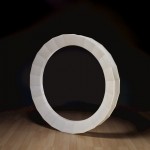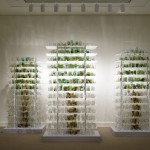Today’s post is from Stefan Zoller, former preparator at the Museum. Stefan is currently a first-year MFA graduate student in painting at Syracuse University.
In preparation for the Museum’s North Wing addition, Thomas Phifer and Partners created a scale model of the gallery space designated for contemporary works. To better visualize how various of the art would be displayed and function in the context of the new space, I was tasked with creating models of a select group of sculpture. These works range from visitor favorites like Karen LaMonte’s Evening Dress with Shawl to recent acquisitions and older works which have not yet been exhibited at CMoG. The complexity and size range of these objects are vast as well, from the minimalistic simplicity of Circular Object I (2009.4.72) by Dan Clayman to the massive towers of densely grouped drinking glasses in Katherine Grey’s Forrest Glass (2010.4.49).
- Circular Object One, Daniel Clayman (American, b. 1957), United States, RI, East Providence, 2003. 2009.4.72
- Forest Glass, Katherine Gray (Canadian, b. 1965), United States, CA, Los Angeles, 2009. 2010.4.49
After determining the dimensions of over 50 objects, I converted each figure to correspond with the model’s 1:24 scale. Then, using object photographs, I cropped, resized, and mounted each to their respective dimensions.
When the models were completed, Tina Oldknow, curator of modern glass, and the head architects met to see what the gallery model would look like populated with sculpture. To better reflect an actual exhibition space, it was decided that each object would need an additional component blocking out the footprint of a security barrier around it. Thus, an object with a footprint of 2 X 2 feet would end up taking up a space close to 8.5 X 8.5 feet.

Tina Oldknow, curator of modern glass, and the head architects met to see what the gallery model would look like populated with sculpture.

To better reflect an actual exhibition space, it was decided that each object would need an additional component blocking out the footprint of a security barrier around it.
Despite the incredible advancements in computer generated 3D architectural rendering, there is still nothing quite like a physical model when it comes to understanding space. Though low-tech, these sculptural models will serve a valuable function in planning CMoG’s new expansion.





1 comment » Write a comment